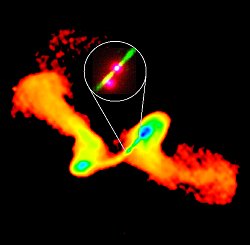
Black holes’ fatal attraction triggers galaxies’ change of heart

Supermassive black holes at the hearts of large galaxies merge when their host galaxies do, say Professor David Merritt of Rutgers University, New Jersey, and Professor Ron Ekers of CSIRO’s Australia Telescope National Facility in Sydney, Australia.
The astronomers make their claim in a paper published online in Science Express on August 1 [U.S. time].
Merritt and Ekers’ model is the strongest evidence to date that the black holes’ mutual attraction ends in an embrace rather than an endless waltz.
Simulations show that when large galaxies merge, interactions between the black holes and stars will make the black holes sink towards the centre of the combined galaxy. But as they approach the centre the black holes will kick out nearby stars, switching off the mechanism that was drawing them together.
“Most astronomers assume that nature finds a way to bring the black holes together, since we don’t see strong evidence of binary black holes at the centres of galaxies,” says David Merritt. “We now have solid evidence that the black hole mergers actually take place.”
That ’smoking gun’ evidence comes from powerful galaxies that shoot ’jets’ of radio-emitting particles from their cores.
Jets signal the presence of a supermassive black hole, millions or billions of times more massive than the Sun. The jets emerge, not from the black hole itself, but from a disk of gas and dismembered stars whirling around it.
About 7% of these galaxies look like their jets have suddenly changed direction. Jets are aligned with the spin axis of the black hole, astronomers think.
“Flipped jets suggest that the black hole has suddenly been realigned,” says Ron Ekers.
Which is just what would happen if two black holes fused, the astronomers say. They show for the first time that even a small black hole can pack quite a punch, knocking another hole up to five times more massive through a large angle.
The idea of black-hole mergers is not new: British cosmologist Martin Rees raised it in a 1978 paper in the journal Nature, for example. But at that time it was too speculative to be taken seriously, Ron Ekers says.
Theorists still can’t explain what draws the black holes together once they have thrown the stars out of their neighbourhood. But when the gulf between the merging holes has shrunk to the size of the solar system, the holes start to radiate away energy as gravity waves, says David Merritt. Then the holes slide inexorably towards fusion, spiralling together faster and faster. Their final clinch releases an enormous burst of gravitational radiation.
The number of radio galaxies with flipped jets, plus the estimated 100-million-year lifetime of the ’radio lobes’ they produce, suggests that these cosmic takeovers happen at the rate of one a year, say Merritt and Ekers. That’s good news for those planning gravity-wave instruments to detect them.
For more information:
Professor David Merritt
Rutgers University
+1-732-445-5742 (office)
merritt@physics.rutgers.edu
Professor Ron Ekers
CSIRO Australia Telescope National Facility
+61-2-6790-4000 (1-2 August only)
0419-146-313 (mobile) or +61-419-146-313 from outside Australia
+61-2-9372-4300 (office, Australia)
Ron.Ekers@csiro.au
Helen Sim, Communications Manager
CSIRO Australia Telescope National Facility
+61-2-9372-4251 (office)
+61-419-635-905 (mobile)
Helen.Sim@csiro.au
Joseph Blumberg, Manager of Science Communications
Rutgers University
+1-732-932-7084 ext. 652 (office)
+1-732-356-3601 (home)
blumberg@ur.rutgers.edu












